Phlox neighbors

Phloxes are very unpretentious flowers, so they occupy a special place in summer cottages. They are most often used to create an alpine slide or garden beds. There are many flowers and shrubs that go well with this flower. All this gives a lot of room for imagination.


Can phlox of different colors be planted together?
Phlox first appeared in North America. In Russia, the flower gained popularity only in the 19th century. At the moment, there are about 80 types of phlox. The overwhelming majority of them are perennial. By the type of growth, flowers are divided into 3 groups.
- Shrub. The flower has more than 10 stems that share one common root. Plants can be tall, medium and short.
- Intermediate. The peculiarity of this species is that the main stems spread along the ground, and from them the shoots begin to grow straight up.
- Creeping. During the flowering period, the bushes look like one solid color carpet. They can occupy a large area.
Phloxes are combined with each other in color, especially when all 3 groups are well played in the design. The perfect blend can be achieved by avoiding sharp contrast. It is best to plant phlox according to this scheme: in the center of the composition there are tall representatives, which can be combined with medium-sized ones, and along the edging or along the path - undersized creeping varieties. Particular emphasis should be placed on the distribution of the shade, and you also need to pay attention to the shape of the petals. Many phloxes have stripes or small spots on their petals. The petals are wavy, even or slightly corrugated. These are small features that are also worth paying attention to in order to get the perfect picture later.
Many summer residents give a simple example of color combinations for a flower bed. A bright contrasting flower is planted in the middle. It may not even be phlox, but, for example, yellow aquilegia. Pink phlox are planted along its contour, then the next circle will be purple, and white phlox are located along the edging in the largest circle.
From this it follows that flowers go very well with each other, if you follow some simple rules of the color wheel. You can try and experiment.
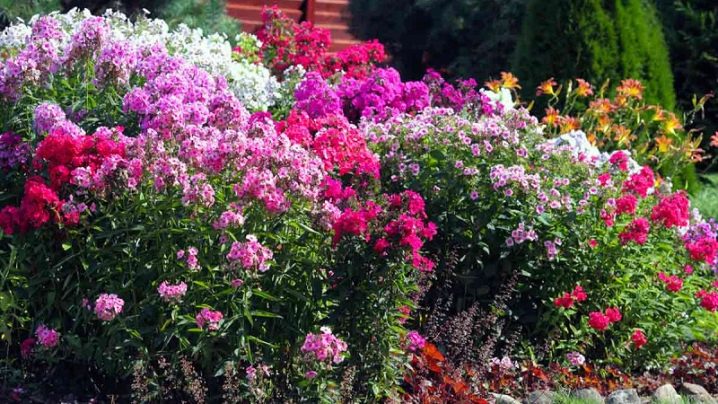
Neighborhood with roses
As mentioned earlier, phlox are unpretentious plants that can be combined with almost all other flowers. Roses are no exception. Before creating such a composition, it is worth remembering that roses always play a leading role. They cannot be pushed into the background, even if other bright flowers are planted in front of them. Therefore, in this combination, phloxes will go in the form of companions, and not as equal elements. Shrub rose goes well with paniculate flowers. If it is tall, then companions are better to choose undersized or creeping varieties, which will be an excellent frame or background. Phloxes can be chosen not only early, which will bloom simultaneously with the rose, but also late ones, which will bloom when the main flowering of the composition comes to an end.
The main criterion for such a composition will be a combination of colors. Flowers should be planted strictly along the color wheel to avoid strong disharmony. A combination works well when the differences between colors are noticeable to the eye.For example, pale pink or pale red, peach and yellow roses will ideally be combined with blue, lilac and dark blue phlox. And also terry compositions go well.
It is worth remembering that both plants are prone to powdery mildew, so they must be planted at a short distance from each other so that there is good air circulation. It is worth inspecting the bushes periodically.
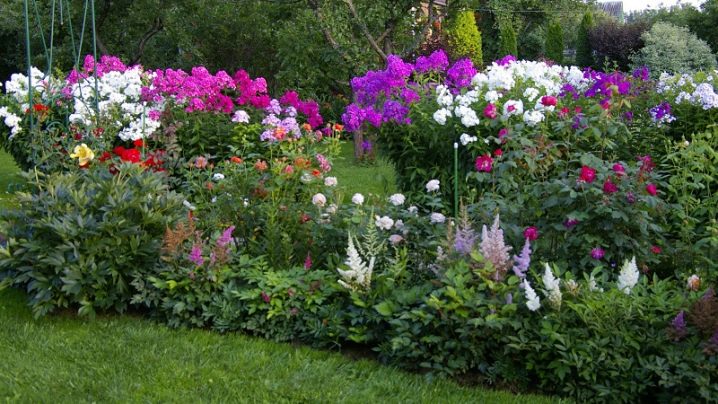
Iris Compatibility
Some summer residents do not recommend planting irises and phloxes nearby. In the former, the root system is very close to the surface of the earth. Any other perennial plants can easily displace irises due to the fact that the roots very quickly fill all the free space.
And also both flowers are affected by rust, which can easily spread to other plants. Therefore, close proximity is not recommended. But at the same time, if we talk about an alpine hill, where other types of plants will coexist, the composition can be distributed so that the flowers will be at a distance from each other.

Compatibility with other colors
Phloxes are very fond of sunlight. Thanks to him, they acquire a rich shade, and along with this, a correct and active development takes place. It is best to pick perennial plants as neighbors in a flower bed. They will have approximately similar root placement and identical growth, and can be matched by flowering period. Some summer residents in landscape design share certain varieties of flowers. For example, a combination of phlox and daylilies is most often used in the backyard landscape. They are planted together in the front garden. Plants are harmonious in terms of flowering duration: they can delight with their buds until autumn. Paniculate flowers look great with daylilies of fawn or pink shades.
Hydrangea, like a rose, fits perfectly into any design. But, unlike the second flower, the hydrangea is not so proud. She never draws all the attention to herself, she is rarely made the center of the composition. If combined with phlox, it is better to choose low-growing plants. It is in this case that the hydrangea will have small leaves, because often phlox leaves are practically invisible due to the large cap of flowers. And according to the ratio of shades, you can select any option you like, the main thing is that they are not too motley.
Peonies are great flowers for alpine slides or flower beds. Their flowering begins in spring and lasts until autumn, if you choose the right varieties. Flowers are located on the back and act as a kind of background, especially when they bloom.
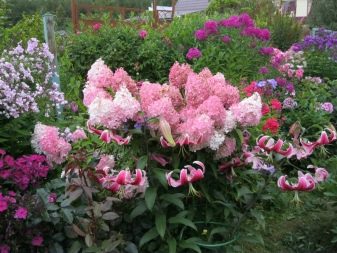

Low-growing plants, which can be phlox, immediately come to the fore.
Phlox combine well with other colors, such as:
- astilba;
- basilis;
- lungwort;
- lupine;
- clematis;
- oriental poppy;
- primrose;
- host;
- crocus;
- scrub;
- narcissus;
- dwarf wormwood;
- splinter.

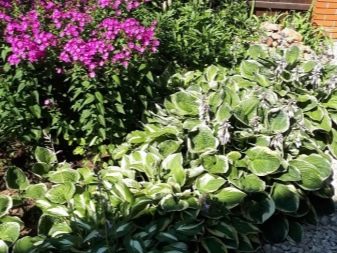
What shrubs can you plant next to?
Phlox go well not only with other flowers, but also with shrubs. Most often, dwarf plants (for example, conifers) are chosen for the flower bed. They are perfectly combined in color, while not shading the flower bed too much. And also compositions are created with rosettes of ornamental cabbage, barberry and spirea. Shrubs are used as a curb that protects flowers from strong winds and rains. Tall shrubs and trees are usually planted away from flower beds. They are used for zoning. Against the background of a pleasant green color, any flower garden begins to play with other, more saturated colors.
A close planting of tall crops is fraught with the fact that the root system of the trees will completely replace phlox and other flowers. The following plants should not be planted nearby:
- spruce;
- poplar;
- lilac;
- Birch;
- willow;
- apple tree and other fruit trees.
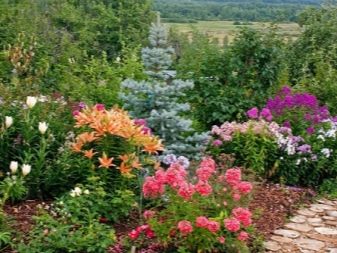
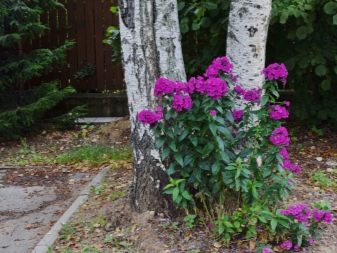







































































































The comment was sent successfully.